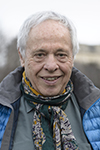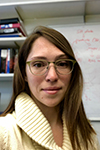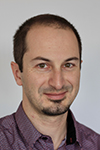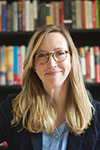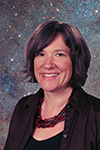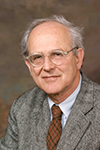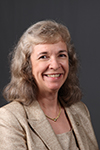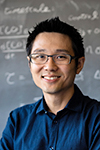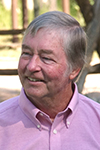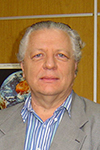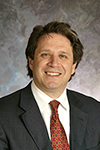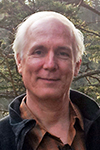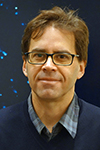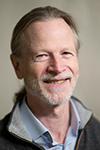AAS Names Recipients of 2018 Awards and Prizes
** Contact details appear below. **
At its 231st semiannual meeting near Washington, DC, the American Astronomical Society (AAS), the major organization of professional astronomers in North America, named the recipients of its 2018 prizes for outstanding achievements in scientific research, instrument development, and writing. AAS President Christine Jones (Harvard-Smithsonian Center for Astrophysics) announced them during her welcome address kicking off the meeting.
The Henry Norris Russell Lectureship, recognizing a lifetime of eminence in astronomical research, goes to Joseph Silk (Institute of Astrophysics, Paris, France), for his contributions to our understanding of the early universe and galaxy formation. Among his many seminal contributions was his prediction of the dissipation of small-scale temperature fluctuations in the cosmic microwave background, an effect that bears his name: Silk damping. Underpinning his scholarly impact is an extraordinary publication record that includes more that 800 refereed articles, of which about 200 are first authored, and eight books. In addition to his direct intellectual legacy are the more than 100 students and postdoctoral researchers whom he has advised over the course of his career.
The Dannie Heineman Prize for outstanding mid-career work in the field of astrophysics is given jointly by the AAS and the American Institute of Physics. For 2018 the prize goes to Vasiliki (Vicky) Kalogera (Northwestern University) for her fundamental contributions to advancing our understanding of the evolution and fate of compact objects in binary systems, with particular regard to their electromagnetic and gravitational wave signals.
Lauren Ilsedore Cleeves (Harvard-Smithsonian Center for Astrophysics) will receive the Annie Jump Cannon Award in Astronomy, which honors outstanding research and promise for future research by a postdoctoral woman researcher. Cleeves is cited for her groundbreaking work on planet formation and protoplanetary disks. Not only has she published impactful theory papers on circumstellar disks, but she also is a successful principal investigator on numerous competitive observing proposals to use state-of-the-art instruments on the ground and in space. Her research promises to expand our knowledge about the chemistry, composition, and structure of the disks that give birth to planets.
The Newton Lacy Pierce Prize, for outstanding early-career achievement in observational astronomical research based on measurements of radiation from a celestial object, goes to Caitlin Casey (University of Texas, Austin). She is honored for her work on high-redshift star-forming galaxies and for pioneering new quantitative techniques for determining the importance of submillimeter galaxies in galaxy evolution. Her measurements of their total luminosities show that submillimeter galaxies have enormous star-formation rates and represent the birth of the most massive galaxies in today's universe. In addition, she has helped establish the existence of protoclusters at high redshift and quantify their properties.
Yacine Ali-Haïmoud (New York University) will receive the Helen B. Warner Prize for a significant early-career contribution to observational or theoretical astronomy, specifically for his extraordinary work on a broad array of cosmological problems. His insights into how to vastly speed up calculations of the effects of hydrogen recombination have proven critical to the interpretation of data from the European Space Agency's Planck spacecraft. His innovative new theory of radiation from spinning dust improved calculations of the effect of massive neutrinos on large-scale structure and clarified how the interaction of baryons with dark matter introduces fluctuations in the 21 cm radiation from the epoch of reionization.
Julianne Dalcanton (University of Washington) is awarded the Beatrice M. Tinsley Prize for an outstanding research contribution to astronomy or astrophysics, of an exceptionally creative or innovative character. Dalcanton is recognized for her pioneering use of large surveys to study low-surface-brightness galaxies and resolve stellar structures in the Milky Way's halo; for her leadership in developing Hubble Space Telescope surveys to create a legacy of data on resolved stellar populations of nearby galaxies; for using multiwavelength observations to create large-scale, innovative, and systematic probes of stellar evolution, of nearby galaxy star-formation histories, and of the interaction of stars and the interstellar medium; and for fostering junior scientists as leaders in these projects.
The George Van Biesbroeck Prize for long-term extraordinary or unselfish service to astronomy, often beyond the requirements of the honoree's paid position, goes to Debra Meloy Elmegreen (Vassar College). Elmegreen served as AAS President from 2010 to 2012 and is honored for her unselfish service to astronomy on regional, national, and international scales, including strengthening public appreciation and support for astronomy, making our community more diverse and inclusive, and acting as a role model and mentor to generations of young astronomers.
Rainer Weiss (Massachusetts Institute of Technology), co-recipient of the 2017 Nobel Prize in Physics, adds the Joseph Weber Award for Astronomical Instrumentation to his many accolades. The Weber Award celebrates the design, invention, or significant improvement of instrumentation leading to advances in astronomy, and Weiss receives it for his invention of the interferometric gravitational-wave detector, which led to the first detection of long-predicted gravitational waves from astronomical sources by the Laser Interferometer Gravitational-wave Observatory (LIGO). The innovation, execution, and persistence in building LIGO set an example that inspires instrumentalists around the globe.
Kevin Heng (University of Bern, Switzerland) will receive the Chambliss Astronomical Writing Award for a university-level textbook. Heng's pioneering graduate textbook Exoplanetary Atmospheres: Theoretical Concepts and Foundations (Princeton University Press, 2017) is a clearly written, well-motivated introduction to the theory of exoplanetary atmospheres, a field of great current and future interest.
The Chambliss Amateur Achievement Award for astronomical research by an amateur astronomer — that is, a person not employed in the field of astronomy in a professional capacity — goes to Donald G. Bruns (Stellar Products, San Diego, California). Bruns is cited for his successful recreation of, and improvement upon, Arthur Eddington's 1919 deflection-of-light experiment during the 2017 total solar eclipse, which represents a tour de force in careful observing and calibration. His work on high-resolution planetary imaging demonstrates extraordinary technical proficiency, including the development of adaptive optics systems for image stabilization in small telescopes. This award also celebrates his passionate sharing of his expertise and excitement with both professional and amateur astronomers.
The AAS Board of Trustees may elect any astronomer of distinction who is not resident in North America as an honorary member. For 2018 this prestigious honor is bestowed upon João E. Steiner (INPE/National Institute for Space Research, Brazil) to recognize his critical contributions to key astronomical facilities in Chile to the benefit of the American astronomy community. He has been a driving force in Brazil, whose help in developing the Southern Astrophysical Research (SOAR) and Gemini telescopes ensured their construction. His continuing support has contributed to the ongoing operation of both facilities. He also helped obtain Brazilian support through the state of São Paulo for the Giant Magellan Telescope, now under construction.
Special Honors at the 231st AAS Meeting
With support from the Kavli Foundation, the Society's Vice-Presidents name a special invited lecturer to kick off each AAS meeting with a presentation on recent research of great importance. Earlier this week, the Kavli Foundation Plenary Lecture, "The New Jupiter: Results from the Juno Mission," was given by Scott Bolton (Southwest Research Institute), the mission's principal investigator.
The closing plenary lecture on Friday will be given by Peter Fritschel (MIT Kavli Institute), co-recipient of the Lancelot M. Berkeley − New York Community Trust Prize for highly meritorious work in advancing the science of astronomy. His lecture, entitled "The Instruments That Launched Gravitational-Wave Astronomy," will feature the Laser Interferometer Gravitational-wave Observatory (LIGO). Fritschel, Dennis C. Coyne (Caltech), and David H. Shoemaker (MIT) are sharing the 2018 Berkeley Prize for their leadership roles in the development of the Advanced LIGO detectors, which have opened a new window on the universe.
AAS Division Prizes
Most of the AAS's six subject-specific divisions also award prizes, and two of them — the Laboratory Astrophysics Division (LAD) and Solar Physics Division (SPD) — have just announced some of their 2018 awardees.
LAD's highest honor, the Laboratory Astrophysics Prize for significant contributions to laboratory astrophysics over an extended period of time, goes to Michael Wiescher (University of Notre Dame) for his leading contributions to the experimental foundation of nuclear astrophysics and for providing a bridge between experiment and theory in this dynamic discipline. His work on explosive nucleosynthesis in novae and X-ray bursters and on nuclear reactions in quiescent stellar burning has opened a new era in our understanding of the evolution of main-sequence stars and of compact stellar remnants in accreting binaries.
Sarbani Basu (Yale University) is receiving the SPD George Ellery Hale Prize, for outstanding contributions to the field of solar astronomy, to celebrate her many seminal contributions to our understanding of the internal structure and dynamics of the Sun and stars. And SPD's Karen Harvey Prize, for a significant contribution to the study of the Sun early in a person's professional career, goes to Nicholeen (Nicki) Viall (NASA Goddard Space Flight Center) for her fundamental contributions to understanding coronal heating and the slow solar wind, and for her valuable service to the science community and the general public.
Buchalter Cosmology Prizes
Ari Buchalter (Intersection) is an astrophysicist-turned-businessman who remains keenly interested in cosmology. In 2014 he endowed the Buchalter Cosmology Prizes to reward new ideas or discoveries that have the potential to produce a breakthrough advance in our understanding of the origin, structure, and evolution of the universe beyond current standard cosmological models. The latest winners of the Buchalter 1st, 2nd, and 3rd prizes were announced at this week's AAS meeting and are Lasha Berezhiani (Max Planck Institute for Physics) and Justin Khoury (University of Pennsylvania); Steffen Gielen (University of Nottingham) and Neil Turok (Perimeter Institute for Theoretical Physics); and Peter Adshead (University of Illinois at Urbana-Champaign), Diego Blas (CERN), Cliff Burgess (Perimeter Institute for Theoretical Physics), Peter Hayman (McMaster University), and Subodh Patil (Niels Bohr Institute), respectively. For details about their work, see Buchalter's press release.
Contact:
Rick Fienberg
AAS Press Officer
+1 202-328-2010 x116
High-resolution images are available from Crystal Tinch, AAS Communications & Engagement Coordinator.
The American Astronomical Society (AAS), established in 1899, is the major organization of professional astronomers in North America. The membership (approx. 8,000) also includes physicists, mathematicians, geologists, engineers, and others whose research interests lie within the broad spectrum of subjects now comprising contemporary astronomy. The mission of the American Astronomical Society is to enhance and share humanity's scientific understanding of the universe, which it achieves through publishing, meeting organization, education and outreach, and training and professional development.


